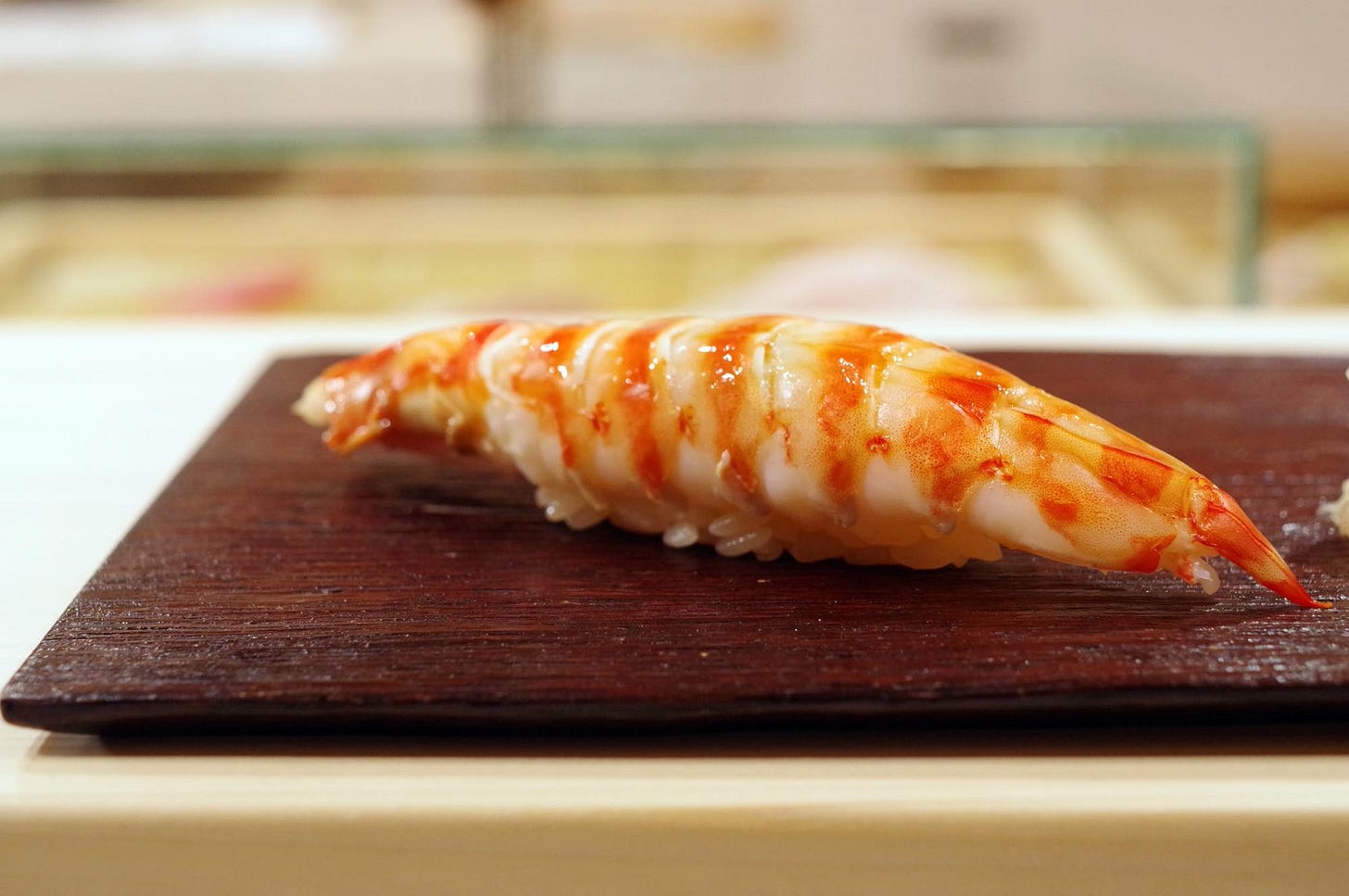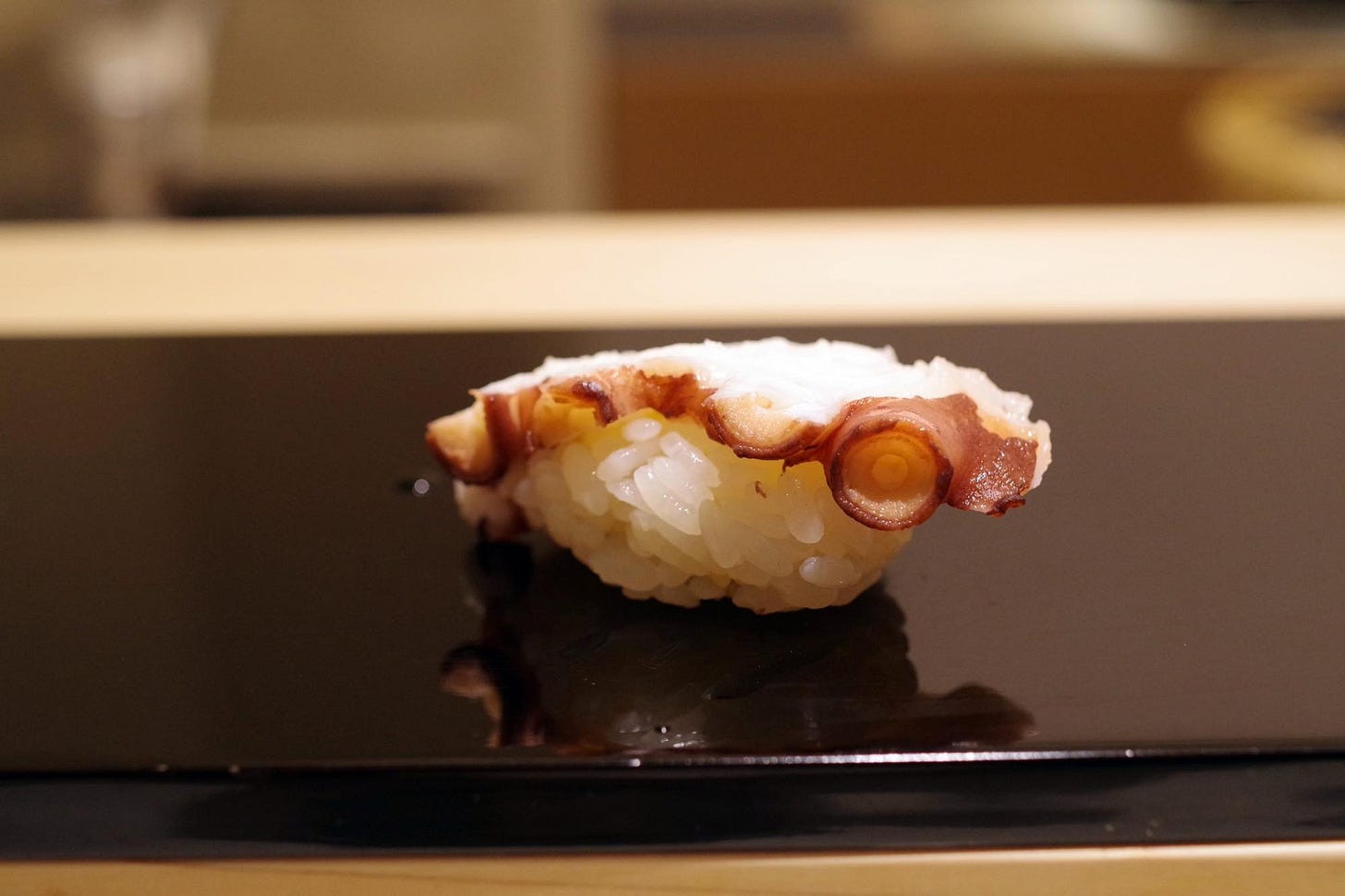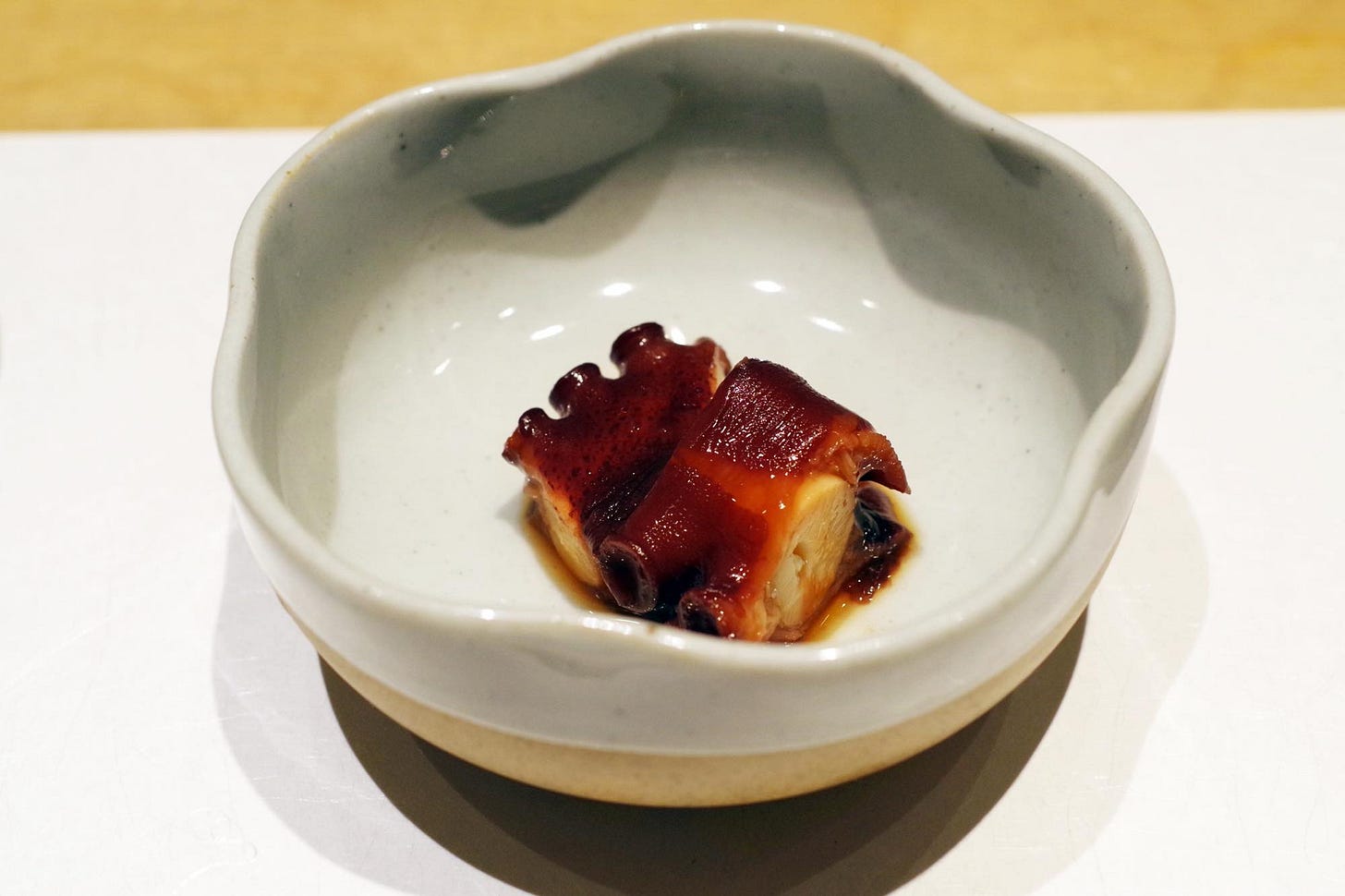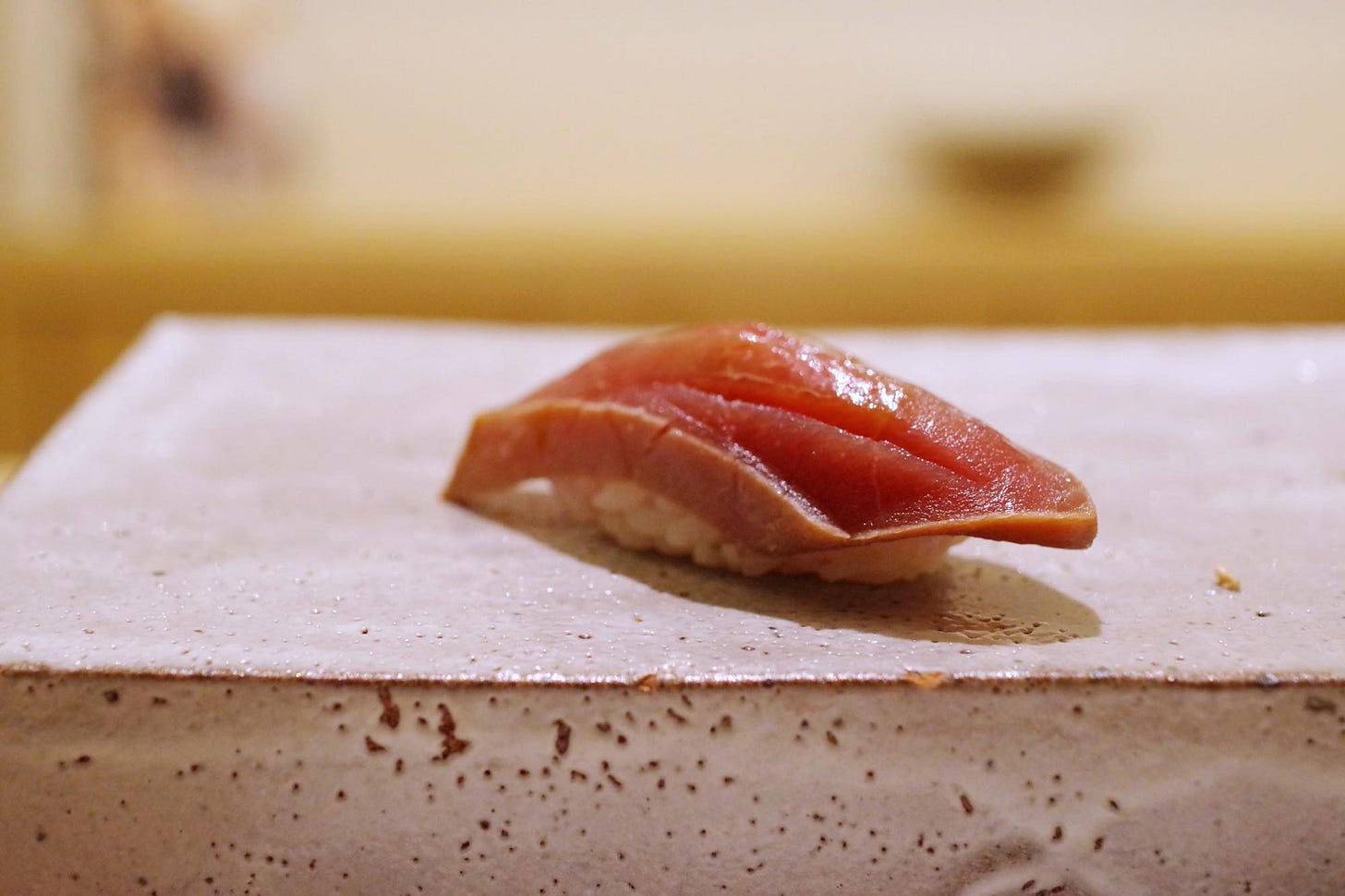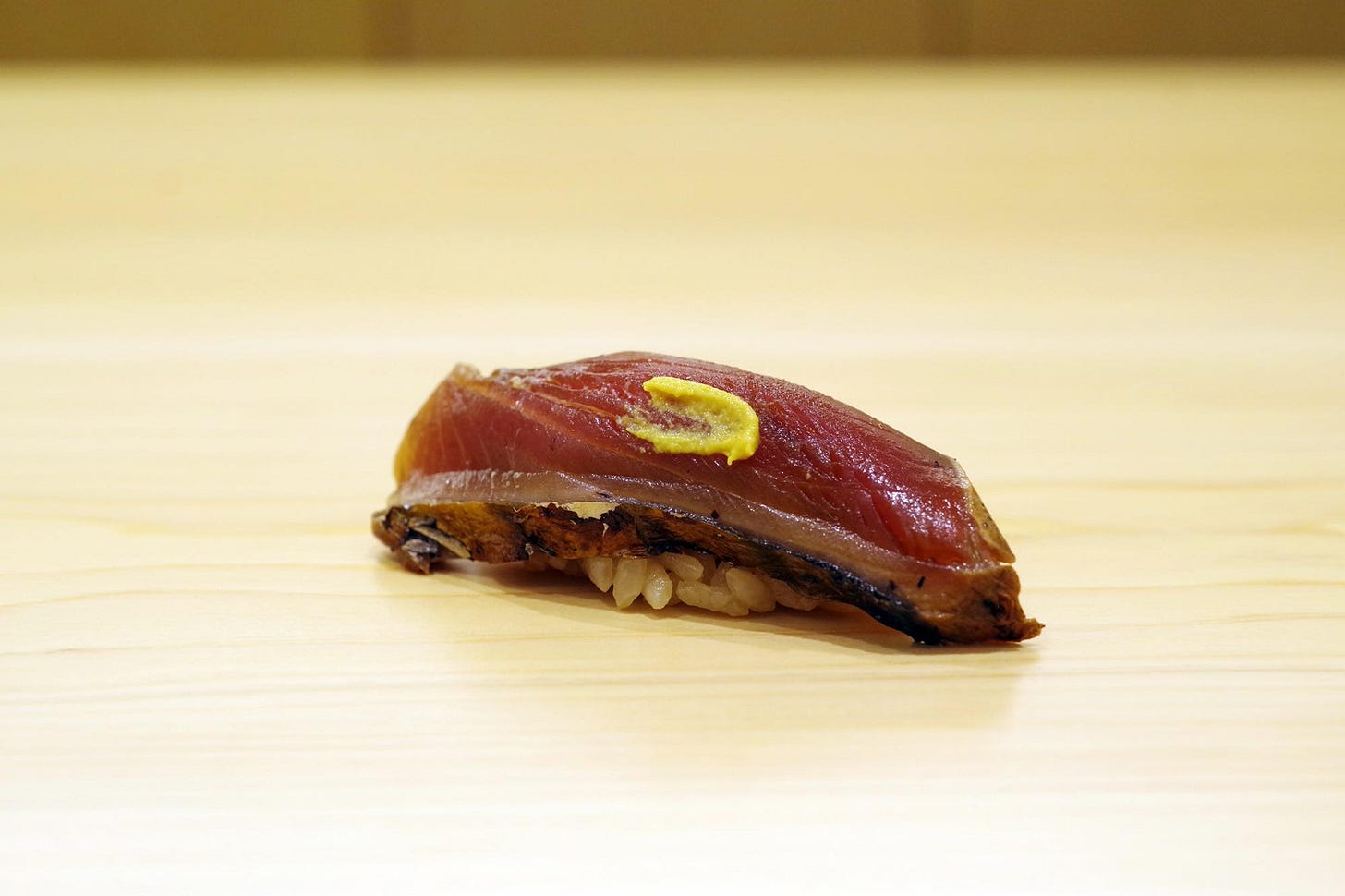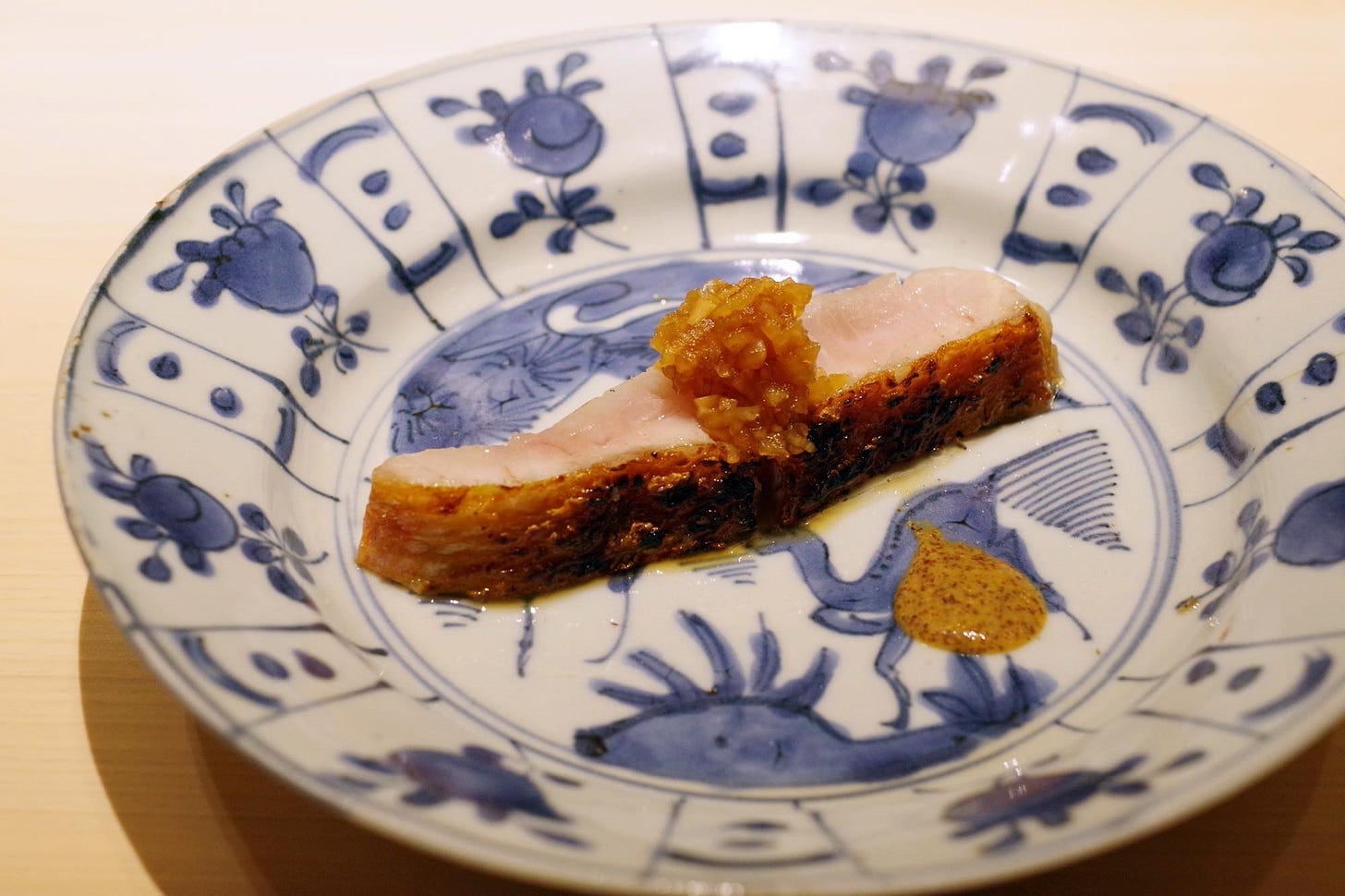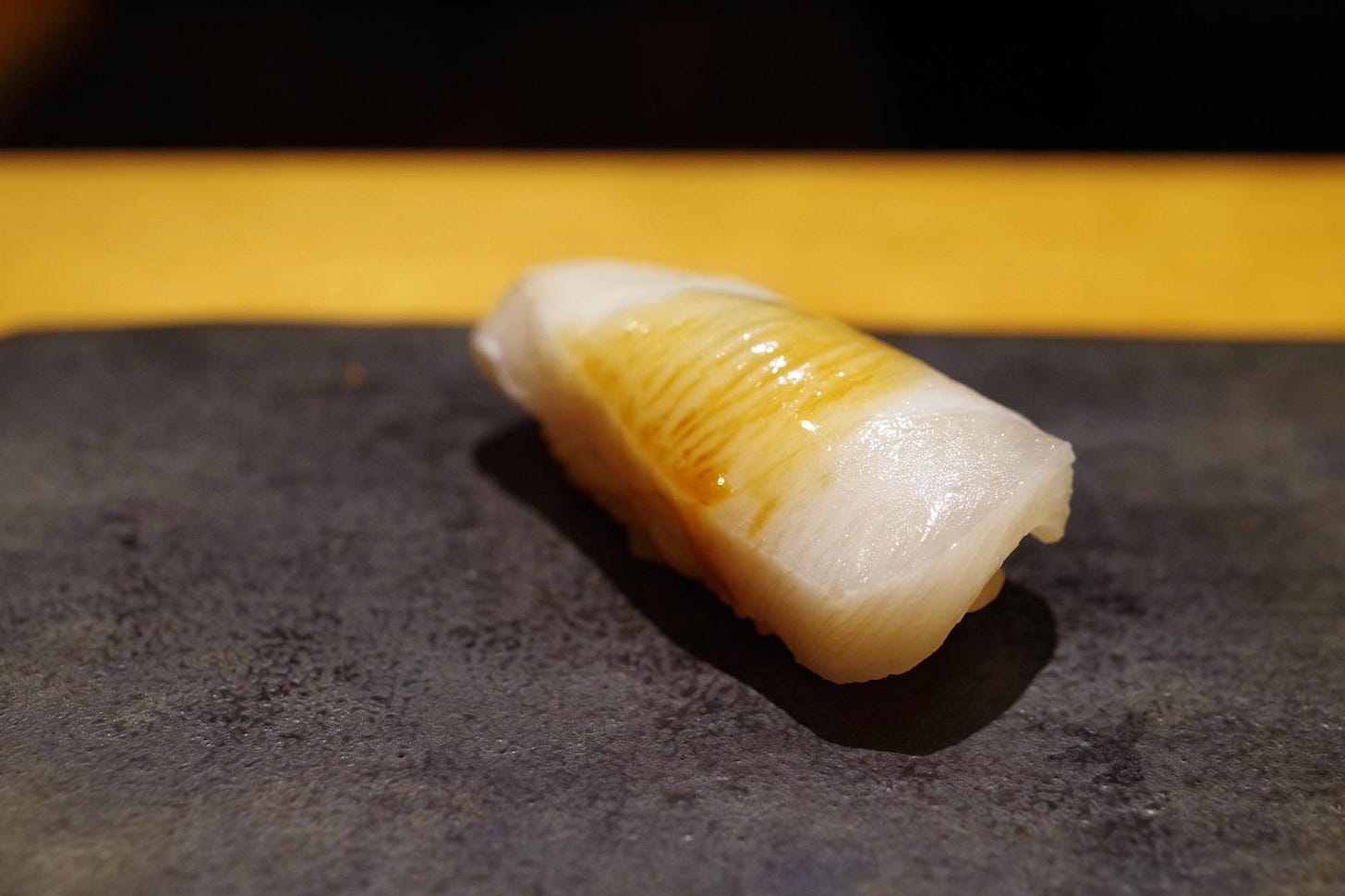In the previous issue, I introduced two “Shigotos” (cooking methods) of Edomae-zushi. In this article, I will delve into other 7 Shigotos in greater detail.
Yude, Boiling: Cooking fish in hot water for a short time.
Niru, Stewing: Cooking fish in hot water or seasoning liquid for a relatively long time.
Tsukeru or Zuke, Pickling: Infusing seafood with flavors through a seasoned solution.
Aburi, Searing: Briefly cooking seafood over a charcoal or gas flame for a short time.
Yaku, Grilling: Briefly cooking seafood over a charcoal or gas flame for a relatively long time.
Nekase, Aging less than about 7 days: Allowing the seafood to rest for a period to enhance its flavors.
Jukusei, Aging: Maturing seafood over time to deepen its taste profile.
“Shigoto” (cooking methods) of Edomae-zushi
Allow me to introduce the various Shigotos or techniques involved in sushi preparation, one by one!
Yude, Boiling
Boiling, a popular technique in Western cuisine, is also a common method in Japanese cooking. In sushi preparation, however, it's primarily used for crustaceans like prawns and various shellfish. Typically, the cooking time is kept relatively short, as opposed to stewing. This brief boiling is crucial because most seafood used in sushi is small, and prolonged boiling can toughen its texture. The purpose of boiling in hot water or seasoned liquid is to remove impurities, moderately firm up the flesh, and enhance the seafood's natural sweet and savory flavors. Modern sushi chefs carefully boil seafood, paying close attention to the texture of each ingredient.
Niru, Stewing
Stewing generally involves a longer cooking time than boiling. This method aims to infuse ingredients with flavors using a seasoned liquid and to significantly alter their texture. It's commonly used for octopus, squid, clams, and other shellfish. While stewing in the Edo period also focused on preservation, today's emphasis is on achieving the right texture and flavor balance. The ideal texture should be neither too soft nor too hard, and the flavor shouldn't overpower. Sushi items like octopus and Hamaguri clams are particularly indicative of a chef’s skill in stewing.
Recently, there’s been a noticeable trend among sushi chefs who are putting more thought into preparing octopus. Not long ago, the “sakura-ni” method, which involves simmering octopus until it's tender and infused with the flavors of soy sauce and mirin (sweet sake), was highly popular. This method, named for its resemblance to “sakura” (cherry blossoms) in color, is quite elegant. However, increasingly, chefs are opting for lighter seasoning to preserve the natural texture of the octopus. While “sakura-ni” has its charm, using the same approach for every chef can diminish the excitement of dining. A strongly flavored dish might taste similar across different restaurants, so chefs aiming to showcase their individuality often opt for subtler flavors, allowing the natural taste of the ingredients to take center stage.
Tsukeru or Zuke, Marinating
This method involves marinating fish in a seasoning solution, often used for fish with robust flavors like tuna or for boiled clams. This preservation technique dates back to the Edo period (1603-1868). In the case of tuna, it was traditionally prepared by pouring boiling water over the raw fish, hardening the surface, and then marinating it, sometimes overnight or even longer. This method is called “Yushimo-zuke” in Japanese (In this context, “Yu” refers to boiling water, and “shimo” means frost, named for the frost-like appearance of ingredients when doused with hot water). The seasoning flavor was typically stronger than that of the tuna itself.
However, in recent years, there's been a shift towards marinating tuna either raw or for just a few minutes up to about a dozen minutes. This change is attributed to advancements in refrigeration technology and a progress of food culture. Essentially, the marinating process is tailored based on a flavor not for a preservation. This method isn't limited to tuna; it's also used for Spanish mackerel (Sawara), bonito (Katsuo), striped horse mackerel (Shima-aji), among other fishes. Today, encountering “Yushimo-zuke” is considered quite fortunate. Sushi chefs who offer “Yushimo-zuke” demonstrate a reverence for classical cooking. If you find it delicious and express your appreciation, it's bound to be a gratifying experience for both you and the chef.
Aburi, Searing
The goal is to quickly sear the surface, melting the fat and imparting a distinct aroma from the searing process. It's also utilized to alter the texture of the seafood. For instance, Hokkigai clams are notably more flavorful when seared. Other examples include searing bonito (Katsuo) over straw or boiling conger eel (Anago) on bamboo leaves. Typically, searing is a quick process; overdoing it turns into grilling, which can diminish the seafood's appeal. Therefore, applying the correct amount of heat is crucial.
Yaku, Grilling
It's often used for sake snacks in sushi restaurants rather than for nigirizushi. The allure of charcoal-grilled oily fish is undeniable. In my opinion, char-grilled fish can rival the experience of a steak from a top-tier steakhouse. While people from countries with a more extensive history of meat consumption than Japan might find this surprising, the vast majority of Japanese people relish the combination of delicious charbroiled fish with white rice. This fondness explains why grilled fish is always well-received as part of the snack menu in sushi restaurants, even in establishments primarily known for their raw fish offerings.
Nekase, Aging less than about 7 days
The “Nekase” process is designed to intensify the flavor of the fish. It's a shorter method than Jukusei”, the more extended aging process, which will be discussed next. “Nekase” means storing the fish in the refrigerator for anywhere from half a day to several days after it has been cured.
Within a few hours after the fish's death, ATP is broken down into inosinic acid (a source of umami), which boosts the umami flavor. This process also tenderizes the texture, creating a better harmony between the firm fish and the vinegared rice. However, while “Nekase” can enhance umami, it may also diminish the fish's natural aroma and texture. Therefore, if all sushi varieties are prepared using “Nekase” or “Jukusei”, they risk becoming monotonous and uninteresting. Recognizing the type of fish being consumed is essential, so the sushi chef must judiciously decide the extent of “Nekase” to apply for each variety.
Jukusei, Aging
“Jukusei” is the process of letting the fish rest for a longer period than “Nekase”, often referred to as aging. I think the term “Jukusei” can be applied to the aging process when it exceeds 5 days, although there is no clear definition for this duration.
Some sushi chefs practice this for more than just one or two weeks, with some even extending the aging period to over three weeks. For instance, at “Sushi Kimura” in Futakotamagawa city in Tokyo. Nearly two-week aging process that was initially applied only to larger fish like tuna has sparked a trend in Tokyo and is now widely adopted.
However, similar to “Nekase”, the duration of “Jukusei” is critical. If the purpose is not to enhance or bring out the fish's flavor, the process loses its significance. It's also crucial to avoid developing negative aromas during aging. A failure in this respect can be seen in some restaurants where the focus on aging results in an unpleasant odor. The ultimate goal of any aging process is to transform the fish into a version that's tastier than its original form. Any deviation from this aim undermines the entire effort.
This marks the end of our exploration into the “Shigotos” (cooking methods) of Edomae-zushi. This volume has been solely dedicated to the art of Edomae-zushi! I am immensely grateful to all the readers who have followed along with my in-depth and detailed narrative.
If you enjoy this article, please share it on your social networks. Your support inspires me to keep writing!
The TOC of “Spirits of Sushi“
Introduction: Unveiling Sushi Secrets
The History of Sushi
Exploring Sushi Varieties: Edomae-zushi (Nigiri-zushi), Kansai-zushi, and More
Essential Sushi Vocabulary: Key Terms for Navigating a Sushi Restaurant
The Heart of Sushi: A Guide to “Shari”, Sushi Rice
A Deep Dive into Sushi Fish and Accompaniments
The Art of the Sushi Master: Traditional Japanese Knives
Japan's Exquisite Fish Culture: From Tsukiji to Toyosu Market and Various Regions
Must-Visit Sushi Restaurants: From Tokyo to Sapporo, Fukuoka, and Other Regions
Regional Sushi Styles: Exploring Japan's Diverse Sushi Culture
Sushi and Sake Pairings: A Culinary Adventure
Sushi Etiquette and Table Manner: Dining like a Sophisticated Local
Shopping in Japan: Essentials for Crafting Delicious Sushi at Home
Sushi in Pop Culture: Manga and Movies
Sushi: A Lens on Health and Sustainability
Wrapping Up: The Future of Sushi





